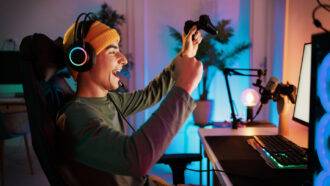Early intro to sign language has lasting benefits
New study recommends introduction should begin in infancy

Silhouette of someone in the process of signing “I love you.”
Bert Heymans/ Flickr (CC BY-SA 2.0)
WASHINGTON, D.C.— When is the best time for a hearing parent to start using sign language with a deaf child? Start when they’re babies, says Peter Hauser. Deaf himself, this scientist reported new findings based on tests of deaf children. Learning sign language in infancy appears to boost brainpower in ways not related to language, he found.
Hauser is a brain researcher at the Rochester Institute of Technology in New York. “Most deaf children are born to hearing families,” he signed during a presentation of his data. “And,” he added, “most hearing parents do not sign with their newborn deaf children.” That means that these children “have very limited exposure to sign language.” This can slow how quickly these kids acquire language. More surprising, Hauser’s research now suggests, late exposure to sign language also appears to affect other type of mental tasks.
He and his colleagues tested 115 deaf children, all around 12 years old. Some had been exposed to sign language from birth. Others didn’t encounter it until they were about three years old. The researchers asked these kids to draw lines between circles with an ordered sequence of numbers. But to make the task tricky, the kids had to alternate colors of the circles they chose. So they had to think about what they were doing, and resist the urge to connect circles of the same color. This test probed something known as executive function. It takes a high degree of mental effort. It involves, for instance, controlling attention, impulses and emotions.
Children exposed to signing from birth connected the dots about 17 seconds faster than the other children, Hauser noted. And late signers don’t seem to ever catch up to those exposed to signing as babies. The evidence? In similar tests of 40 adults, signers-from-birth beat the times of late signers by 23 seconds, he reported.
Hauser shared his team’s new data here on February 12 at the annual meeting of the American Association for the Advancement of Science.
This result shows that whatever changed is “something that’s still there in adulthood,” says Jenny Singleton of the Georgia Institute of Technology in Atlanta. She’s a psychologist and language expert. Earlier work by Singleton had tested classrooms of deaf children. There too, some had been exposed to signing from birth and some had only learned to sign later. Late signers required more help to follow signed conversations, her team found.
There’s now strong and growing evidence in kids, she says, “to suggest that if they have not acquired [sign] language early, there can be lifelong impacts.” And families of deaf children who receive cochlear (KO-klee-ur) implants to restore hearing shouldn’t necessarily abandon attempts to sign, she adds. If a child doesn’t succeed with the implant, then signing can ensure a child still has a language to use.
Power Words
(for more about Power Words, click here)
cochlea A spiral-shaped structure in the inner ear of humans and other mammals. The natural battery in the mammalian inner ear provides power to drive signals from the ear to the brain. Those signals travel along the auditory nerve.
cochlear implant An electronic device inserted into the ear of people who are deaf. It consists of a microphone and speech-processing computer chip. In some people, depending on the source of their deafness, it can successfully relay some useful sounds to give them some sense of hearing.
executive function The term that includes all of the brain functions needed for self-regulation, self-control and problem-solving. Executive function requires good working memory to hold several pieces of information in the brain at once. It also includes multi-tasking, prioritizing, reasoning, focus, concentration, goal setting and controlling impulses.
implant A device manufactured to replace a missing biological structure, to support a damaged biological structure, or to enhance an existing biological structure. Examples include artificial hips and knees, pacemakers, and the insulin pumps used to treat diabetes.
neuroscience Science that deals with the structure or function of the brain and other parts of the nervous system. Researchers in this field are known as neuroscientists.
psychology The study of the human mind, especially in relation to actions and behavior. To do this, some perform research using animals. Scientists and mental-health professionals who work in this field are known as psychologists.







